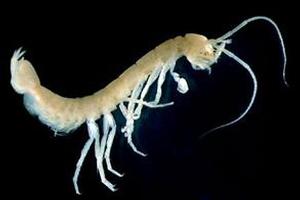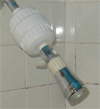October 2009
Go here if you'd like to read this issue on our website.
An email extension of the Pure Water Gazette.
In this issue of the Occasional you'll hear about water-scrubbing phreatoicids, ceramic water filters, and galvanized pipes. Find out how to get rid of benzene, how to get free humming lessons, and how to recognize bacteria by their swimming stroke. Find out the identity of the oldest water filter company in the world and the name of the sneaky pathogens that may be lurcking in your shower head. Discover how many gallons of water can be treated with a single bottle of bleach, hear about a man who died of drinking too much water, and as always, much, much more. The Occasional is overseen and edited by Pure Water Gazette editor Hardly Waite.
Water News from Around the World
While you weren't paying attention, a lot of important things went by. Follow the links if you want to read more.
Despite much gnashing of teeth, New York will have deposit on bottles.
University of Colorado research has found that bathroom shower heads can deliver "a face full of pathogens," including Mycobacterium avium, a pathogen linked to pulmonary disease.
Yale University engineers for the first time tracked the classy upstream swimming technique of e. Coli.
Many alternative energy projects are being held back because they use massive quantities of water.
Ancient creatures called phreatoicids are keeping New Zealand's water clean.

Ancient Creature Scrubbing Water (See tiny sponge in upper left hand)
Providing Water for Emergencies
by Gene Franks
Our filter depends on the natural force of siphoning to draw water through the filter. It works by submerging a single Doulton ceramic candle with an attached tube in a container of water, starting a siphoning action by sucking on the tube, then allowing the filtered water to be collected in a container lower than the first. (Illustration and full details.)
A bit later, we developed a variation on the basic ceramic siphon filter, this time using a state-of-the-art carbon block filter cartridge, the Multi-Pure VOC, for which we made a siphoning adapter similar to the one used for the Doulton candle. With this filter standard household bleach is required. Water is purified with bleach (a single gallon of bleach is enough to treat 38,000 gallons of questionable water), then filtered through the NSF-certified Multi-Pure cartridge. (Illustration and details.)
Chlorine has been used by municipalities to make water safe from bacterial contamination since early in the last century. It will still work even if computers fail or if a flood knocks out your city's water supply system. Ceramic filters were invented for the purpose of making the polluted water of the Thames safe to drink. With the help of the principle of siphoning, which has never been known to fail, either chlorine or filtration through ceramic can provide safe water for emergencies even in the absence of electrical power or pressurized water.
Featured Water Issue: Benzene
This issue's featured water issue is benzene, an EPA regulated chemical contaminant of water and a known carcinogen. The EPA maximum allowable for benzene is only 5 parts per billion. Benzene enters the environment from a variety of sources. In drinking water, the main source of this contaminant is gasoline, often through leaking gasoline storage tanks and fuel spills.
The best way to get benzene out of drinking water is with activated carbon filtration. This means that if you have a high quality carbon filter or reverse osmosis drinking water system, benzene should not be a worry. Benzene can also be treated with ozone.
Go to the Occasional's Water Issues section for a full discussion of benzene and other water issues.
How it works
Several new articles have been added to the Occasional's How It Works series of straightforward explanations of how water treatment devices function. For example, whole house reverse osmosis, backwashing filters, and undersink filters have been added recently.
Humming is Good For You
by Hardly Waite
Bodies, tiger or human or anteater, have no unnecessary parts; neither do they have unnecessary gestures, sensations, and activities. Coughing, belching, hiccupping, scratching, frowning, spitting, wheezing, twitching, snorting, weeping, snarling, blinking, yawning, farting, flinching, sneezing, smiling, itching, licking, pouting, slobbering, shivering, laughing, grieving, groaning, hurting--all have their purpose.--Tiger Tom, On Pain.
Gazette Columnist Tiger Tom can now add humming to his list of essential activities, for Swedish researchers have proven something that is obvious to anyone who pays attention: Humming is good for you.
Please click the picture for details. |
You'll Hum Better! |
The researchers measured hummers' exhalation levels by tracking nitric oxide (NO), a gas produced in the lungs and nasal passages to help blood vessels dilate. Humming increased the NO released into the nose from the sinuses.
Humming also facilitated the exchange of air from sinuses into nasal passages, which essentially ventilates the sinuses and protects them from infection.
If you need more information on the science of the issue, please go to American Journal of Respiratory and Critical Care Medicine 2002;166:144-145
If you just want to experience for yourself the exhilarating efficacy of Hardly Waite Humming Therapy, throw away your sinus drops and start humming. Start and end each day by humming at least two verses of the "Ode to Joy" section of Beethoven's Ninth Symphony. Your sinuses will rejoice and your spirits will soar.
And, if after 5 years of Hardly Waite Humming Therapy you conclude that it hasn't given you healthier sinuses and a more joyful disposition, just write me and I'll cheerfully give you double your money back.
Disclaimer: The Pure Water Gazette does not recommend that you hum without consent and direction of a qualified health professional.
Note: The article above is reprinted from the Pure Water Gazette's web site. See what you're missing by not reading the Gazette.

